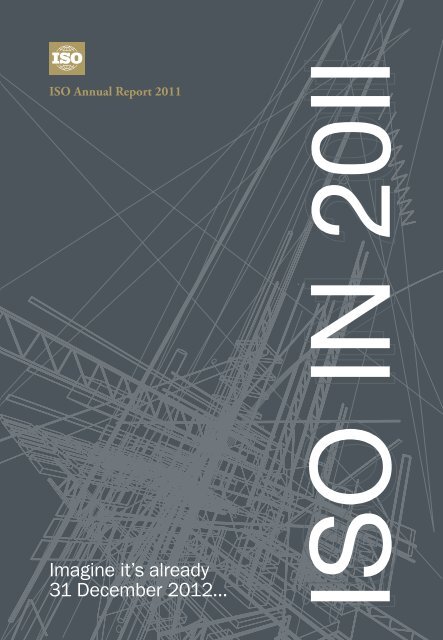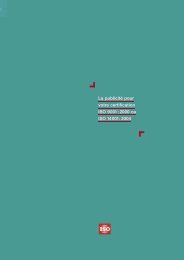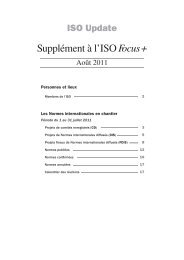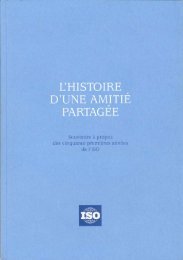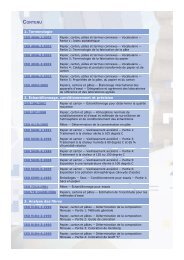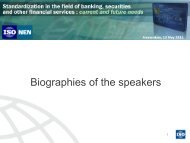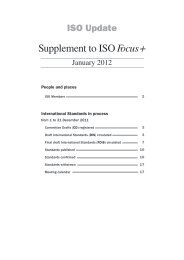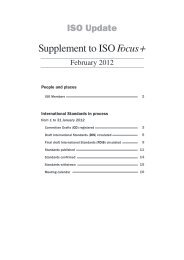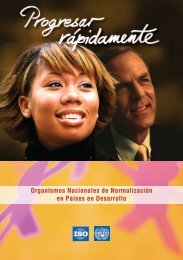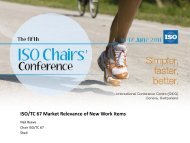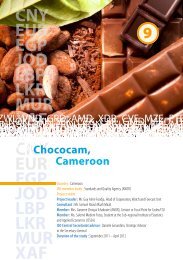ISO Annual Report 2011
ISO Annual Report 2011
ISO Annual Report 2011
You also want an ePaper? Increase the reach of your titles
YUMPU automatically turns print PDFs into web optimized ePapers that Google loves.
<strong>ISO</strong> <strong>Annual</strong> <strong>Report</strong> <strong>2011</strong><br />
IN 20II<br />
<strong>ISO</strong><br />
Imagine it’s already<br />
31 December 2012…
Contents<br />
Imagine it’s already 31 December 2012… ...................... 1<br />
<strong>ISO</strong> as seen by users, customers and stakeholders ..... 2<br />
Outro-duction ............................................................................................ 24<br />
<strong>ISO</strong> highlights of <strong>2011</strong> ..................................................................... 25<br />
The pillars of the <strong>ISO</strong> system ...................................................... 30<br />
<strong>ISO</strong>’s secret formula for successful standards ............ 32<br />
<strong>ISO</strong> in fi gures in <strong>2011</strong> ...................................................................... 34<br />
Portfolio of <strong>ISO</strong> standards and<br />
Draft International Standards .................................................... 36<br />
Principal offi cers .................................................................................... 37<br />
<strong>ISO</strong> structure ............................................................................................. 42<br />
Membership ............................................................................................... 44<br />
Member bodies ................................................................................. 45<br />
Correspondent members .......................................................... 46<br />
Subscriber members .................................................................... 46<br />
<strong>ISO</strong> member bodies’ contribution<br />
to the standards process ......................................................... 47<br />
Financial statements ......................................................................... 48<br />
You’ve read the report,<br />
now watch the <strong>ISO</strong> videos ! .......................................................... 52<br />
<strong>ISO</strong> President,<br />
Dr Boris Aleshin :<br />
“ For our customers, the users<br />
of <strong>ISO</strong> standards, what counts<br />
for them are the results they<br />
achieve through implementing<br />
our standards.”
<strong>ISO</strong> <strong>Annual</strong> <strong>Report</strong> <strong>2011</strong><br />
The conventional annual report focuses on the importance of<br />
the organization and what it does. The <strong>ISO</strong> <strong>Annual</strong> <strong>Report</strong> <strong>2011</strong><br />
tries something different. Imagine it’s already 31 December<br />
2012 – for you to agree that <strong>ISO</strong> has done a great job, what<br />
would it have had to do for you ?<br />
To give you an idea of the potential of <strong>ISO</strong> standards to benefit<br />
you, this annual report focuses not on what <strong>ISO</strong> has to say<br />
about itself, but on what a selection of the users, customers and<br />
stakeholders of <strong>ISO</strong> standards had to say in <strong>2011</strong>. They come<br />
from both public and private sectors, and some of them actually<br />
participate in the development of <strong>ISO</strong> standards.<br />
<strong>ISO</strong> President, Dr Boris Aleshin, in a speech in <strong>2011</strong>, after<br />
referring to the launching of the <strong>ISO</strong> Strategic Plan <strong>2011</strong>-2015,<br />
commented : “ Having a strategy is not enough. As Churchill<br />
once said, ‘ However beautiful the strategy, you should occasionally<br />
look at the results.’ And for our customers, the users<br />
of <strong>ISO</strong> standards, what counts for them are the results they<br />
achieve through implementing those standards.”<br />
SO WHAT?<br />
Imagine it’s already 31 December 2012…<br />
What could <strong>ISO</strong> have done for you?
<strong>ISO</strong> in brief<br />
<strong>ISO</strong> is the International Organization for Standardization.<br />
<strong>ISO</strong> has a membership of 163 national standards bodies<br />
from countries large and small, industrialized, developing<br />
and in transition, in all regions of the world. <strong>ISO</strong>’s portfolio<br />
of over 19 000 standards provides business, government<br />
and society with practical tools for all three dimensions<br />
of sustainable development: economic, environmental<br />
and social.<br />
Biometrics for security –<br />
payments – Metric system – an unsung hero –<br />
Cabling standards score in football coverage –<br />
Smart card registration increases interoperability<br />
and security – Australian dentists get their teeth<br />
into <strong>ISO</strong> 26000 – <strong>ISO</strong> and UN’s Millennium<br />
Development Goals (MDGs) – Singapore’s larges<br />
retailer backs <strong>ISO</strong> standards – Building on <strong>ISO</strong><br />
standards – <strong>ISO</strong> standards and developin<br />
countries – Cannes achieves top billing with IS<br />
standards – <strong>ISO</strong> 50001 – Save energy, save th<br />
planet – Russia’s Premier Vladimir Putin back<br />
<strong>ISO</strong> standards – Good things for SMEs – IS<br />
standards and supply chains – <strong>ISO</strong> standards f<br />
global players – European Commission suppor<br />
<strong>ISO</strong> 26000 – Pushing back the space frontier – IS<br />
standards share best practice – <strong>ISO</strong> standards<br />
today, for tomorrow – “ Vital relationship ” betwe<br />
WTO and <strong>ISO</strong> – How <strong>ISO</strong> International Standa<br />
enefits for a world of seven billion peopl<br />
users<br />
customers<br />
and<br />
An <strong>ISO</strong> International Standard represents a global consen-<br />
stakeholders<br />
<strong>ISO</strong> standards make a positive contribution to the world<br />
we live in. They facilitate trade, spread knowledge, disseminate<br />
innovative advances in technology, and share<br />
good management and conformity assessment practices.<br />
<strong>ISO</strong> standards provide solutions and achieve benefits<br />
for almost all sectors of activity, including agriculture,<br />
construction, mechanical engineering, manufacturing,<br />
distribution, transport, healthcare, information and communication<br />
technologies, the environment, energy, safety<br />
and security, quality management, and services.<br />
<strong>ISO</strong> only develops standards for which there is a clear market<br />
requirement. The work is carried out by experts in the subject<br />
drawn directly from the industrial, technical and business<br />
sectors that have identified the need for the standard, and<br />
which subsequently put the standard to use. These experts<br />
may be joined by others with relevant knowledge, such as<br />
representatives of government agencies, testing laboratories,<br />
consumer associations and academia, and by international<br />
governmental and nongovernmental organizations.<br />
sus on the state of the art in the subject of that standard.<br />
2<br />
<strong>ISO</strong><strong>Annual</strong><strong>Report</strong><strong>2011</strong><br />
<strong>ISO</strong> as seen by<br />
,<br />
201
“Daon relies on <strong>ISO</strong> bio metrics<br />
standards in providing platforms<br />
for the entire identity<br />
life cycle, spanning applications<br />
that include border management,<br />
transportation and credentialing<br />
of employees and citizens… Biometrics<br />
technology has become an<br />
essential weapon in the worldwide<br />
fight against both terrorism threats<br />
and identity theft.”<br />
Safeguarding<br />
financial payments<br />
Catherine<br />
Tilton,<br />
Vice<br />
President of<br />
Standards<br />
and Emerging<br />
Technology at<br />
Daon, USA.<br />
Biometrics for security<br />
4<br />
Photo : © Daon<br />
“Payment standards, and in particular<br />
payment security standards, are<br />
a cornerstone of the retail payments<br />
system. <strong>ISO</strong>…develops standards<br />
that are critical in enabling nearly<br />
instantaneous execution of billions<br />
of transactions annually representing<br />
trillions of dollars in payments…<br />
Financial institutions the world over<br />
could not have built the globally<br />
interoperable, multi-billion-dollar<br />
card payments system without <strong>ISO</strong><br />
security and related standards.”<br />
Photo : © Daon<br />
John F. Sheets,<br />
Senior Business Leader<br />
responsible for Payment<br />
Technology Development<br />
for Visa, Inc.<br />
Metric system<br />
an unsung hero<br />
Anders J Thor,<br />
formerly an<br />
Assistant Professor<br />
of Mechanics at<br />
the Royal Institute<br />
of Technology in<br />
Stockholm, Sweden.<br />
Anders J Thor passed<br />
away on 7 April 2012.<br />
Paul Gérôme,<br />
professional<br />
taxonomist trained<br />
in anthropology<br />
(Doctorat d’Etat de la<br />
Sorbonne), semiotics,<br />
general system theory<br />
and dermo-science,<br />
Paris, France.<br />
Jean-Paul<br />
Lemaire, works<br />
for the University<br />
Paris Diderot for<br />
the French National<br />
Research Center<br />
(CNRS).<br />
“From baking a cake to transmitting security<br />
data – quantities and units enable every aspect of<br />
our lives. Without the metric system contained<br />
in International Standards, a whole range of<br />
activities, from shopping at the supermarket to<br />
industrial production, to scientific research, to<br />
international trade, would be at best extremely<br />
haphazard.”<br />
<strong>ISO</strong><strong>Annual</strong><strong>Report</strong><strong>2011</strong> <strong>ISO</strong><strong>Annual</strong><strong>Report</strong><strong>2011</strong><br />
5
Football is the focus of massive<br />
television, radio and newspaper<br />
coverage, serving millions of fans<br />
around the world with images,<br />
data, and a wealth of information<br />
on matches, teams and players.<br />
But how are all these images and<br />
pieces of information transmitted<br />
to the gigantic video screens<br />
in football stadiums, to public<br />
viewing sites, and simultaneously<br />
to television and the Internet ?<br />
“ <strong>ISO</strong>/IEC 11801 and<br />
<strong>ISO</strong>/IEC 24702 have definitely<br />
created a huge push for the<br />
cabling industry. By providing<br />
guidance to the end-user and<br />
cabling vendor, the two International<br />
Standards have clarified<br />
customer demands, and shaped<br />
and focused the entire industry.<br />
“ The demanding performance<br />
targets defined by the standards<br />
required deeper understanding<br />
of the physics involved, and<br />
triggered incredible progress in<br />
Cabling standards score<br />
in football coverage<br />
Photo : © R&M<br />
Matthias Gerber,<br />
Head of Presales<br />
Engineering at Reichle<br />
& De-Massari AG,<br />
Switzerland.<br />
possible data transmission speed. On the customer<br />
side, standardization has reduced the risks of stranded<br />
investments, and has helped to future-proof infrastructure<br />
investments.”<br />
Photo : © R&M<br />
Photo : © R&M<br />
Graeme Freedman,<br />
a leading<br />
international expert<br />
in smart card and<br />
related technology.<br />
Smart card registration<br />
increases interoperability and security<br />
The appointment of SAI Global as the worldwide<br />
<strong>ISO</strong>/IEC 24727-6 Smart Card Registration<br />
Authority for authentication protocols conforming<br />
to the standard ensures greater interoperability<br />
and security in this technology which<br />
plays such a vital role in establishing identity<br />
so that services such as healthcare, banking and<br />
transport go to the right person.<br />
“This new approach has been long awaited and<br />
is welcomed by both developers and adopters of<br />
smart card technology… This is especially the<br />
case for governments and other major organizations<br />
that are looking for ways to inter-operate<br />
between local, national and international smart<br />
card schemes in an increasingly globalized world.”<br />
<strong>ISO</strong><strong>Annual</strong><strong>Report</strong><strong>2011</strong><br />
7
Australian dentists<br />
Garry Pearson,<br />
Chief Executive<br />
Officer of the<br />
Australian Dental<br />
Association<br />
Victorian Branch<br />
(ADAVB), Inc.<br />
8<br />
Photo : © ADAVB<br />
Photo : © ADAVB<br />
get their teeth into <strong>ISO</strong> 26000<br />
The Australian Dental Association Victorian<br />
Branch (ADAVB) became one of the first<br />
entities to take up <strong>ISO</strong> 26000, which gives<br />
guidance for social responsibility.<br />
“ After consulting <strong>ISO</strong> 26000, ADAVB has<br />
mapped actions taken by the association – such<br />
as cleaner waste water from dental cabinets,<br />
and environmental and community health<br />
and welfare campaigns – against the guidance<br />
in the standard. This has demonstrated just<br />
how effective <strong>ISO</strong> 26000 can be in implementing<br />
social responsibility, particularly for<br />
those for whom SR sounds like a good idea,<br />
but who question how, in concrete terms,<br />
one should implement it.”<br />
<strong>ISO</strong> and UN’s<br />
Millennium Development Goals (MDGs)<br />
“<strong>ISO</strong> has developed a large set of standards in the environmental field which are<br />
quite complementary with the UNECE norms and conventions in this area and<br />
thereby also contribute to the achievement of the MDG 7 on environmental<br />
sustainability. And there are many other examples on how <strong>ISO</strong> standards help<br />
organizations meet the MDGs.<br />
“For instance, <strong>ISO</strong> 26000 helps organizations achieve the benefits of operating<br />
in a socially responsible manner and is directly linked to MDG 3, ‘ Gender<br />
equality ’. Thus, the core subjects and issues of social responsibility defined<br />
by <strong>ISO</strong> 26000 include human rights, labour practices, the environment, fair<br />
operating practices, consumer issues and community involvement which<br />
encompass, among other things, the principles of equal opportunities and<br />
non-discrimination.<br />
“<strong>ISO</strong> 9000 has an important impact on<br />
education and many educational institutions<br />
have been called upon to use these standards.<br />
It contributes to MDG 2, ‘ Universal primary<br />
education ’.<br />
“The role of International Standards in economic<br />
development has been emphasized on<br />
many occasions, more particularly with the<br />
reference to the standards in the Technical<br />
Barriers to Trade Agreement of the World<br />
Trade Organization (TBT WTO).”<br />
Photo : © UN Photo/Sergio da Silva<br />
<strong>ISO</strong><strong>Annual</strong><strong>Report</strong><strong>2011</strong> <strong>ISO</strong><strong>Annual</strong><strong>Report</strong><strong>2011</strong><br />
Photo : © UN<br />
Sergei A.<br />
Ordzhonikidze,<br />
Director-General<br />
(2002-<strong>2011</strong>),<br />
United Nations<br />
Office at Geneva,<br />
Switzerland.<br />
9
Singapore’s largest retailer<br />
backs <strong>ISO</strong> standards<br />
Photo : © NTUC FairPrice<br />
Photo : © NTUC FairPrice<br />
Seah Kian<br />
Peng, Chief<br />
Executive Officer<br />
(Singapore) of<br />
NTUC Fairprice<br />
Co-operative (240<br />
outlets).<br />
“International Standards are very important to us. It gives<br />
credit to the great lengths that we have gone through to ensure<br />
that the end product delivered to all FairPrice customers is<br />
both affordable and of the best quality… As one of the leading<br />
supermarket retailers, FairPrice plays a key role in being<br />
an early adopter of standards and through this we spur other<br />
industry players to do the same.”<br />
Photo : © NTUC FairPrice<br />
Photo : © NTUC FairPrice<br />
Carole Le Gall,<br />
Chief Executive<br />
Director of the<br />
Scientific and<br />
Technical Centre<br />
for Building<br />
(CSTB), France.<br />
Building<br />
on <strong>ISO</strong> standards<br />
Photo : © CSTB<br />
Photo : © CSTB<br />
“In order to describe the performances<br />
which need to be integrated into a project,<br />
International Standards are necessary. People<br />
also move around and work internationally.<br />
They expect to be able to rely on International<br />
Standards for a certain level of comfort and<br />
safety…<br />
“Sustainable development has to take into<br />
account both local and international challenges.<br />
International Standards are a means<br />
of addressing these issues at a global level,<br />
disseminating best practice. Participation<br />
in standards development ensures that all<br />
interests are taken into account, whether<br />
industry, regulators or consumers.”<br />
10<br />
<strong>ISO</strong><strong>Annual</strong><strong>Report</strong><strong>2011</strong> <strong>ISO</strong><strong>Annual</strong><strong>Report</strong><strong>2011</strong> 11<br />
Photo : © CSTB
<strong>ISO</strong> standards and<br />
developing countries<br />
Ulf Källstig,<br />
Head of Unit<br />
for Global<br />
Programmes<br />
at the Swedish<br />
Agency for<br />
International<br />
Development<br />
Cooperation<br />
(Sida).<br />
Photo : Ylva Sahlstrand/Sida<br />
Photo : Roger Lundholm/Universitetssjukhuset i Lund<br />
Photo : Ylva Sahlstrand/Sida<br />
Working to improve capacity of national standards<br />
bodies (NSBs) in developing countries is<br />
an important task outlined in the <strong>ISO</strong> Action<br />
Plan for Developing Countries <strong>2011</strong>-2015 and<br />
an important building block towards more<br />
inclusive trade – locally, regionally and globally.<br />
“To have developing country partners at the<br />
table is important in all international affairs,<br />
particularly in facilitating development for<br />
the poor. <strong>ISO</strong>’s Action Plan works twofold by<br />
both bringing partners to the table, and offering<br />
capacity building for actors in developing<br />
countries. That is why it is in line with Swedish<br />
development priorities.<br />
“Sida’s reason for supporting <strong>ISO</strong> is to stimulate<br />
economic growth that will have the potential to<br />
benefit poor people in less developed countries,<br />
and to do so with a ‘ rights perspective ’ (i.e.<br />
targetting the work so that underprivileged<br />
groups benefit from the standard).”<br />
Photo : Magnus Saemundsson/ Sida<br />
Photo : Victor Brott<br />
© Palais des Festivals et des Congrès de Cannes – Photo : Ajuria<br />
Youri Golovko,<br />
Purchasing<br />
Manager and<br />
QSE Manager<br />
of the Palais<br />
des Festivals et<br />
des Congrès of<br />
Cannes, France.<br />
Cannes achieves top billing<br />
with <strong>ISO</strong> standards<br />
The city of Cannes in France has achieved<br />
international renown through its film festival.<br />
Today, its Palais des Festivals et des Congrès is one<br />
of the top performing convention centres in<br />
Europe. In order to reach this objective, it implemented<br />
a strategy based on <strong>ISO</strong> International<br />
Standards <strong>ISO</strong> 9001 (quality management) and<br />
<strong>ISO</strong> 14001 (environmental<br />
management)<br />
and the non-<strong>ISO</strong><br />
OHSAS 18001 standard (occupational health<br />
and safety).<br />
“Implementing <strong>ISO</strong> standards clearly provides<br />
a competitive advantage in order to face<br />
international trade challenges and generate<br />
new growth opportunities.”<br />
12<br />
<strong>ISO</strong><strong>Annual</strong><strong>Report</strong><strong>2011</strong> <strong>ISO</strong><strong>Annual</strong><strong>Report</strong><strong>2011</strong> 13
Win the energy challenge with<br />
<strong>ISO</strong> 50001<br />
<strong>ISO</strong> 50001<br />
energy management<br />
Win the energy challenge with <strong>ISO</strong> 50001.indd 1 <strong>2011</strong>-06-07 16:27:27<br />
<strong>ISO</strong> 50001<br />
Save energy, save the planet<br />
Paul Scheihing,<br />
Acting Supervisor,<br />
Technical Assistance,<br />
Industrial Technologies<br />
Program, at the US<br />
Department of Energy.<br />
Ken Hamilton,<br />
Director, Global Energy<br />
and Sustainability<br />
Services, Hewlett-<br />
Packard (USA).<br />
Daryl Liao, Executive<br />
Vice-President of Delta<br />
Group’s China region.<br />
“ Based on broad applicability across national<br />
economic sectors, the <strong>ISO</strong> 50001 standard (energy<br />
management) could eventually influence up to<br />
60 % of the world’s energy demand.”<br />
“ <strong>ISO</strong> 50001 – a ‘ very pragmatic standard ’ that<br />
will help companies to integrate energy management<br />
with business practices. It will allow<br />
multinational companies like Hewlett-Packard<br />
to reduce energy costs and increase the efficiency<br />
of energy use throughout global supply chains.”<br />
“ With the implementation of the <strong>ISO</strong> 50001<br />
energy management system in the Dongguan<br />
region, and production capacity at an even<br />
level from January to May of this year, we<br />
have already reduced power consumption by<br />
10.51 million kWh as compared to the same<br />
period in 2010. This is equivalent to a reduction<br />
of 10.2 thousand tons of carbon emissions and<br />
a saving of CNY 8 million.”<br />
Good things<br />
for SMEs<br />
Per Frode, CEO<br />
of Baltic Safety<br />
Products, Sweden.<br />
Martin Denison,<br />
Managing Director<br />
of Scuba Schools<br />
GmbH, Austria.<br />
10 things<br />
good<br />
for<br />
SMEs<br />
International<br />
Organization for<br />
Standardization<br />
Ten Good Things for SMEs - EN.indd 1 <strong>2011</strong>-07-28 11:31:55<br />
Managers of small businesses in 10 countries from around the world testified<br />
how <strong>ISO</strong> standards contribute to their success in a new <strong>ISO</strong> brochure, 10 good<br />
things <strong>ISO</strong> does for SMEs.<br />
“ The payoff for engaging in standards work is<br />
greater than many small business people realize.<br />
Standards are both important and interesting. For<br />
a company like Baltic Safety, it’s essential to get<br />
involved with the working groups so we can get<br />
started early with our planning for future designs<br />
and production methods. Globalization means<br />
that <strong>ISO</strong> standards are key for any company that<br />
hopes to succeed in export markets.”<br />
“ Without standards I would have had to close down…<br />
Not taking part (in standardization) would have cost<br />
me my company and my livelihood…What does it<br />
cost me if I do not get involved and others define<br />
rules that are out of line with my needs, interests<br />
and experiences, but which I have to comply with<br />
because they are laid down in a standard ? Hence,<br />
it is best to join in right at the start.”<br />
14<br />
<strong>ISO</strong><strong>Annual</strong><strong>Report</strong><strong>2011</strong> <strong>ISO</strong><strong>Annual</strong><strong>Report</strong><strong>2011</strong><br />
15
“I think that globalization and<br />
worldwide trade make it more<br />
relevant for International Standards<br />
to play a key role in today’s<br />
business.<br />
“If you look, for example, at our<br />
sourcing processes in DuPont,<br />
we have an initial self-assessment<br />
questionnaire for potential suppliers,<br />
followed by on-site audits.<br />
The questionnaire includes the<br />
certification requirements for<br />
<strong>ISO</strong> 9001 and <strong>ISO</strong> 14001,<br />
respectively. This provides a<br />
reliable source of confidence in<br />
our supply chains…<br />
“These <strong>ISO</strong> standards are important<br />
for our diversified businesses,<br />
not only to deliver quality<br />
products and services, but in the<br />
context of speaking one language :<br />
the international language of<br />
standards.”<br />
16<br />
<strong>ISO</strong><strong>Annual</strong><strong>Report</strong><strong>2011</strong><br />
<strong>ISO</strong> standards and<br />
supply chains<br />
Photo : DuPont Image<br />
Photo : DuPont Image<br />
Photo : DuPont Image<br />
Ian Hudson,<br />
President –<br />
DuPont Europe,<br />
Middle East<br />
and Africa,<br />
and President<br />
– DuPont<br />
de Nemours<br />
International<br />
SA, Geneva,<br />
Switzerland.<br />
Photo : Daimler AG<br />
“The early adoption of internationally recognized<br />
standards serves to establish conditions<br />
for uniform regulation and efficient<br />
technology development. This enables not<br />
only investments to be planned, but also<br />
provides the basis for a global competition<br />
and mature innovations…<br />
“International Standards open doors for our<br />
products worldwide. We are a global player<br />
with globally located research, development<br />
and production sites. Therefore, we need<br />
to observe global standards. These serve<br />
to increase work efficiency in our research<br />
and development, planning, procurement,<br />
production and aftersales operations and<br />
simplify the strong cooperation we enjoy<br />
with our technology partners…”<br />
<strong>ISO</strong> standards<br />
for global players<br />
Dr. Thomas<br />
Weber, member<br />
of the Board of<br />
Management<br />
of Daimler AG,<br />
responsible for<br />
Group Research<br />
and Mercedes-<br />
Benz Car<br />
Development.<br />
Photo : Daimler AG<br />
Photo : Daimler AG<br />
Photo : Daimler AG<br />
17
Photo : NASA<br />
Photo : NASA<br />
Pushing back<br />
the space frontier Ken Wheatley,<br />
Senior Vice<br />
Photo : NASA<br />
Christopher<br />
J. Scolese,<br />
Associate<br />
Administrator,<br />
National<br />
Aeronautics<br />
and Space<br />
Administration<br />
(NASA), USA.<br />
“People sometimes forget that standards evolve<br />
with time. This is a job that <strong>ISO</strong> and the <strong>ISO</strong><br />
community do very well – they adapt as we<br />
learn things. International Standards are the<br />
repository of our knowledge, of the knowledge<br />
of the community. They explain it and maintain<br />
it well : they are the caretakers.<br />
“At the same time, we are constantly learning and<br />
updating our standards. This is done through<br />
a formal process to make sure that everyone<br />
understands the same thing. Our duty is to<br />
communicate the correct information, not only<br />
to the current generation of engineers, but to<br />
future generations of engineers and scientists.”<br />
Photo : Sony<br />
Photo : Sony<br />
President and<br />
Chief Security<br />
Officer, Sony<br />
Electronics,<br />
Inc., USA.<br />
Photo : Sony<br />
Photo : Sony<br />
“<strong>ISO</strong> has played a huge role in Sony’s effort to not only become more efficient<br />
and quality oriented in our manufacturing processes through <strong>ISO</strong> 9001 (quality<br />
management systems), but also to reduce our environmental impact and<br />
save costs across the company through <strong>ISO</strong> 14001 (environmental management<br />
systems). All of Sony’s sites with 100 employees or more are certified to<br />
<strong>ISO</strong> 14001, globally…<br />
“International Standards like <strong>ISO</strong>’s help companies discover inefficient, unnecessary<br />
and in some cases dangerous practices that can lead to a whole host of<br />
undesirable outcomes. Many of the industry’s leading best practices in place<br />
today were developed in response to issues found during some stage of an <strong>ISO</strong><br />
standard implementation.”<br />
18<br />
<strong>ISO</strong><strong>Annual</strong><strong>Report</strong><strong>2011</strong> <strong>ISO</strong><strong>Annual</strong><strong>Report</strong><strong>2011</strong> 19<br />
<strong>ISO</strong> standards<br />
share best practice
<strong>ISO</strong> standards<br />
for today, for tomorrow<br />
Photo : Lockheed Martin<br />
Photo : Lockheed Martin<br />
Rick Johnson,<br />
Vice President<br />
and Chief<br />
Technology<br />
Officer,<br />
Lockheed Martin<br />
Information<br />
Systems &<br />
Global Solutions<br />
(IS&GS), USA.<br />
“ Starting with <strong>ISO</strong> 9001, the <strong>ISO</strong> standards<br />
give us a defined and focused management<br />
system. This management system has provided<br />
numerous benefits from cost containment<br />
to quality products to timely delivery of our<br />
customer’s contracts over the years. The addition<br />
of <strong>ISO</strong>/IEC 27001 (information security<br />
management), with its focus on security, and<br />
<strong>ISO</strong>/IEC 20000 (IT service management), with<br />
its focus on service, has allowed Lockheed Martin<br />
IS&GS to enhance its management system with<br />
a baseline for today, yet focused on tomorrow.”<br />
“ Vital relationship ”<br />
between WTO and <strong>ISO</strong><br />
Pascal Lamy, Director General of the World<br />
Trade Organization (WTO), emphasized the<br />
“ vital relationship ” between the WTO and<br />
<strong>ISO</strong> in a video message to the 34 th <strong>ISO</strong> General<br />
Assembly in New Delhi, India.<br />
“ The work you do – the work of setting standards<br />
– is crucial for international trade, ” he<br />
said. In conclusion, the WTO Director General<br />
told the delegations of <strong>ISO</strong> member countries :<br />
“ Please see this message as an encouragement<br />
by the WTO for the development of further<br />
International Standards. Ones that are developed<br />
transparently and inclusively ; and which capture<br />
state-of-the-art technology. Once again, allow me<br />
to express my appreciation for the collaboration<br />
between our respective organizations. It must<br />
be maintained and I am confident that it will.”<br />
20<br />
<strong>ISO</strong><strong>Annual</strong><strong>Report</strong><strong>2011</strong> <strong>ISO</strong><strong>Annual</strong><strong>Report</strong><strong>2011</strong><br />
Photo : WTO<br />
Photo : WTO
<strong>ISO</strong> standards meet trade<br />
and sustainability challenges<br />
India’s Minister of State for Consumer Affairs,<br />
Food and Public Distribution, Prof. K. V. Thomas.<br />
The <strong>ISO</strong> President, Dr. Boris Aleshin.<br />
22<br />
<strong>ISO</strong><strong>Annual</strong><strong>Report</strong><strong>2011</strong><br />
At the opening on 21 September <strong>2011</strong> in New<br />
Delhi of <strong>ISO</strong>’s 34 th General Assembly, Prof.<br />
K. V. Th omas, India’s Minister of State for<br />
Consumer Aff airs, Food and Public Distribution,<br />
said : “ We recognize standardization as<br />
a vital component of our growth engine, an<br />
important facilitator of trade and a major tool<br />
for protection of consumer interest.”<br />
<strong>ISO</strong> Secretary-General, Rob Steele with the President of ANSI, host of the next<br />
<strong>ISO</strong> General Assembly, Joe Bhatia.
INDIA<br />
34 th <strong>ISO</strong> General<br />
Assembly<br />
19-24 September <strong>2011</strong><br />
New Delhi, India<br />
<strong>2011</strong>-11-08 11:03:02<br />
Béatrice Frey, who retired in <strong>2011</strong> from her leadership of the<br />
Bureau of the Secretary-General, was honoured for her 39<br />
years of service at <strong>ISO</strong> Central Secretariat.<br />
<strong>ISO</strong><strong>Annual</strong><strong>Report</strong><strong>2011</strong><br />
23
Outro-<br />
How <strong>ISO</strong> International Standards<br />
offer benefi ts for a world<br />
of seven billion people<br />
<strong>ISO</strong> Secretary-General,<br />
Rob Steele :<br />
“ <strong>ISO</strong> standards are made by<br />
people to help solve problems<br />
for people.”<br />
24<br />
<strong>ISO</strong><strong>Annual</strong><strong>Report</strong><strong>2011</strong><br />
(<strong>ISO</strong> press release, 1 November <strong>2011</strong>)<br />
As the world population achieves a new landmark of seven<br />
billion people, <strong>ISO</strong> standards off er practical tools for sustainability<br />
and a better, safer world.<br />
According to the United Nations Population Fund (UNFPA),<br />
the population of our planet has now reached seven billion<br />
people 1) . It said “ Th is unique moment in human history<br />
represents both an achievement and a challenge, and will have<br />
an impact on every single person on the planet. A world of<br />
seven billion has implications for sustainability, urbanization,<br />
access to health services and youth empowerment – however,<br />
it also off ers a rare call-to-action opportunity to renew global<br />
commitment for a healthy and sustainable world.”<br />
<strong>ISO</strong> Secretary-General Rob Steele commented : “Standards<br />
play a pivotal role in facilitating the interaction of so many<br />
people. Every day, thousands of <strong>ISO</strong> standards help people<br />
at work, in the home and at play, by promoting quality and<br />
effi ciency, making lives safer and more comfortable, fostering<br />
economic prosperity and looking after our planet. And that<br />
is because <strong>ISO</strong> standards are made by people to help solve<br />
problems for people.”<br />
Examples include standards for food safety, medical devices,<br />
1) Th e UN recognizes that its own fi gures come with a 1-2 % margin of error, and the<br />
world’s population could actually be 56 million higher or lower.
duction<br />
social responsibility, building and construction, transportation<br />
and fi ghting climate change. Whether we are pressing on the<br />
brake of a car, playing ice hockey protected by a helmet, or<br />
using a computer, <strong>ISO</strong> standards make an important contribution<br />
to our safety and effi ciency.<br />
As the world population reaches seven billion, International<br />
Standards can help address the ever growing challenge of sustainability.<br />
For example, standards for food and water quality<br />
and for energy management can contribute to an eff ective use<br />
of resources. And standards for new technologies help promote<br />
and deploy innovations crucial to facilitating the lives of a<br />
rising population. In fact, most <strong>ISO</strong> standards contribute in<br />
one way or another to addressing the economic, societal and<br />
environmental aspects of sustainability.<br />
What makes <strong>ISO</strong> so eff ective is that it provides a non-political,<br />
non-partisan platform where standards are developed through<br />
open, transparent processes by representatives of the people<br />
who need them, implement them, are aff ected by them – and<br />
who can review and continually improve the results of their<br />
implementation.<br />
Th is is why <strong>ISO</strong> standards help translate agreements reached<br />
at events like the Earth Summit and the forthcoming Rio+20,<br />
into practical actions that can be implemented worldwide.<br />
<strong>ISO</strong><strong>Annual</strong><strong>Report</strong><strong>2011</strong> 29
<strong>ISO</strong> highlights of <strong>2011</strong><br />
Volume 2, No. 1, January <strong>2011</strong>, ISSN 1729-8709<br />
• Guest Interview : WTO Director-General Pascal Lamy<br />
• Management systems integration<br />
<strong>ISO</strong> Strategy<br />
<strong>2011</strong>-2015<br />
<strong>ISO</strong> Focus 11-01_E.indd 1 <strong>2011</strong>-03-30 10:55:22<br />
<strong>ISO</strong> Focus+ magazine focuses on<br />
the <strong>ISO</strong> Strategic Plan <strong>2011</strong>-2015<br />
International Organization<br />
for Standardization<br />
<strong>ISO</strong> Central Secretariat<br />
1, chemin de la Voie-Creuse<br />
Case postale 56<br />
CH - 1211 Genève 20<br />
Switzerland<br />
www.iso.org<br />
© <strong>ISO</strong>, <strong>2011</strong><br />
All rights reserved<br />
ISBN 978-92-67-10556-7<br />
Win the energy challenge with<br />
<strong>ISO</strong> 50001<br />
<strong>ISO</strong> 50001<br />
energy management<br />
Win the energy challenge with <strong>ISO</strong> 50001.indd 1 <strong>2011</strong>-06-07 16:27:27<br />
<strong>ISO</strong> launches <strong>ISO</strong> 50001 energy<br />
management standard<br />
Economic benefi ts of standards<br />
R<br />
B<br />
PEG_<strong>ISO</strong> national standards bodies_ROUGE.indd 1 2010-12-09 10:05:05<br />
ZWL, WL WNOK, VND, SKK, GRD, SEK, AMD, CZK, XDR, CSK, CVE, GMD, MZE, MKD, PTE,<br />
HNL, NOK NOK NOK NOK NOK NOK, NOK, NOK,,,, VND ND ND ND<br />
DZ<br />
TPE, AFA, HKD,<br />
SLL, SK SK SK SK SK SK SSSSSS SSS SSSS S<br />
OA, TG, FA FA FA FA FA FA FA FA FA FA FA FA FA FA FA FA FA FA FA FA FA FA FA FA FA FA FA FA FA FA FA FA FA FA FA FA FA FA BHD, EUR, AFN, SBD,<br />
MDL,<br />
IQD, CHE, XAG, JMD,<br />
ROL,<br />
JOD, MGA, ANG, BBD,<br />
RON,<br />
KWD, THB, AWG, LRD,<br />
BGL,<br />
AOK, LYD, PAB, NAD, NLG, BGN,<br />
RSD, ETB, NZD, HUF, SZL, VEB, CSD, ADF, SGD,<br />
MTL VEF,<br />
HP, TL, BHD, A, A, A, A, A, A, AA AA AA, A, A, A, A, A, A, A, A, HD, HD, HD, HD, HD, SD<br />
ZN, BEF, TND, BOB,<br />
PYG, , , , , , , , , , ,,, , AFN, AFN,<br />
SRD, SML, TMM, SDP,<br />
D, DD,<br />
DD, D, DDDDDD,,,,,,,,,,,,,,,,,,,, AFN AFN AFN AFN AFN AFN AFN AFN AFN AFN AFN AFN AFN AFN AFN AFN AFN AAFN<br />
AFN AFN AFN AFN AFN AFN AFN AFN AFN AFNNNNNN AFN AFN AFN AFN AFN AFN AFN, AFN, AFN, AFN AFN AFN AFN AFNN AFN, AFN, AFN, AFN, AFN AFN AFN AFN, AFN, AFN, AAAFN AAAAF AAF AAF AF AAF AAF AAF AAF AFFFFFF AF AAF AAF AAF AAF AAF AAF AAF AFFFFFFFFFFFF AFN AFN AAFN<br />
AAFN AF AFF AF AFFFF AAAA AFN AFN AFN AF AFFFFFF AF AFFFF AFN AAA AF AF AF AF AF AF AF AF AF AAAAAAAAAAAAAAA AF AAF AAF AAAF AAF AAAAAAF AAF AAAAAF AF AAAAAF AAF AAF AAAAF AAF AAAAAAF AAF AAF AAAAF AAF AAAAAAAAAAAAAAAAAAAAAAAAAAAAAAAAAAA AFN AAFNNNNN AAF<br />
AAF AAF AAAF AAF AAF AAAAF AAF AAAAFFF AF AAAF AAAF AAF AAF AAAAF AF AAF AAFFF AF AAF AAAAAFF AF AAF AAAAAFF AFN, AFN, AAAFN AFN AAF AF AAFN<br />
AFN AAAAAAAAAAF AF AF AF AF AF AFFFFFFF AF AF AF AF AF AF AF AFFFFFFFFF AF AAF AFFFFFFFFFFFFFFFFFFFFFFFFFFFFFF FN FFFFFFFFFF N, NX NX NN,<br />
N, II<br />
I IQ IQ IQ IQ IQ I<br />
BIF, TWD, GHC, YUD, VAL, SDG, UAH, , , , , , , , ,<br />
, , , , AON, XX<br />
XX<br />
XX<br />
XX<br />
XX<br />
XX<br />
XX<br />
XX<br />
XX<br />
XX<br />
X<br />
XX<br />
X XX<br />
XX<br />
X X X<br />
X<br />
KMF, TMT, CRC, YUM,<br />
PGK, AOR,<br />
TTD, LTL,<br />
CDF, SYP, DEM, SVC, USD, AED, CYP, TRL, LAK, MMK,<br />
DJF, BAM, NIC, USS, MAD, EGP, HRK, GEL,<br />
FRF, TRY, NIO, FIM, USN, FKP, STD, GNF, GBP, DKK,<br />
MWK, GIP, MZM,<br />
LVL,<br />
ZWD, AUD, LUF, LSL, EEK, IEP, ZMK, MZN,<br />
ALL,<br />
BOV, O O O O O O O OB, OB, OB, OB, OOOB, OB, OB, OB, OB, OB, OB, OB, OB, OB, OB, OB, OB, OB OB, OB OB OB, OBB OB, OB, OB, OB, OB, OB, OB OB OB OB OB OB OB OB OB OB OB OB OB OB OB OB OB OB OB OB OB OB OB OB OB OB OB OB OB OB OB OB OB OB OB OB OB OB OB OB OB OB OB OO OB OB OO OO OB OB OO OO OOOB OB OO OO OD, D, D, BB BB BB BB BB B BB BB<br />
BB BB ERN, , , , , , , ,<br />
, , , , GHC GHC GHC GHC GHC GG<br />
GHC GHC GHC GHC GHC GHC GHC GHC GHC GH GH GHC GHC GH GHC GGHC<br />
GHC GHC GHC GHC GH GHC GH GHC GGHC<br />
GHC GHC GH GG<br />
GHC GHC GH GGH<br />
GG<br />
GHC GHC GHC GH GH GH GHC GH GH GH GH GH GH GH GHC GHC GHC GG<br />
GGHC<br />
GG<br />
GH GH GH GH GGH<br />
GH GGHC<br />
GGH<br />
GHC GHC GGH<br />
GH GH GGH<br />
GH GH GGHC<br />
GHC GHC GG GGHC<br />
GH GH GG GH GH GHH GGH<br />
GGH<br />
GGH<br />
GH GH GGHH<br />
GH GH GH GH GH GGHC<br />
GHC GG GG<br />
GHC GH GGHH GG<br />
GG<br />
GH GH GHHH GH GGH<br />
GH GH GHH GH GH GHH GH GH GH GH GHC GHC GH GHH GH GH GHHH GH GH GHH GH GHH GHC GH GHC GHC GHC GH GH HHC<br />
HH HCCCCC<br />
C CC<br />
CC<br />
CD<br />
DD<br />
NGN, BTN, XAU, MRO, TOP, XPD, ZWR, MGF, BSD, LBP, AZM ISK, MO<br />
RWF, BZD, ZD ZD ZD ZD ZD ZD ZD, ZD, ZD, ZD ZD WF, WF, DD BM BMD BMD BMD BMD BMD BMD BMD BMD BMD BMD BMD BMD, CHF, CHF CHF MM<br />
XOF, BND, XAF, KYD, XPF, CAD, XFO, XCD, XFU, FJD, CHW, GYD,<br />
Economic benefi ts<br />
of standards<br />
CNY<br />
NOK<br />
THB<br />
CNY<br />
BRL<br />
PEG_<strong>ISO</strong> liaison organizations_VERT.indd 1 2010-12-08 16:11:57<br />
How to ensure <strong>ISO</strong> standards keep<br />
on delivering top benefits<br />
International case studies<br />
International<br />
Organization for<br />
Standardization<br />
<strong>ISO</strong> collection of international<br />
case studies proves economic<br />
benefits of standards<br />
Cover - Economic benefits of Standards.indd 1-3 <strong>2011</strong>-08-18 08:55:16<br />
Book - How <strong>ISO</strong> standards help - Climate change.indd 1 2010-12-13 12:07:02<br />
<strong>ISO</strong> brochure provides<br />
overview of GHG programmes<br />
<strong>ISO</strong> 14001 - Are you ready - E.indd C1 2010-12-06 15:25:31<br />
<strong>ISO</strong>/ITC handbook/CD package puts<br />
<strong>ISO</strong> 14001 within easier reach of SMEs<br />
Best-selling <strong>ISO</strong> standards available<br />
in e-book formats<br />
The fifth<br />
Russia’s Premier Vladimir Putin backs <strong>ISO</strong> standards<br />
<strong>ISO</strong> Chairs’<br />
Conference<br />
International<br />
Organization<br />
for Standardization<br />
Simpler,<br />
faster,<br />
better.<br />
16− 17 June <strong>2011</strong><br />
International Conference Centre (CICG)<br />
Geneva, Switzerland<br />
<strong>ISO</strong> standards makers address how to<br />
make <strong>ISO</strong> simpler, faster, better<br />
<strong>ISO</strong> Survey –<br />
Certifications up by + 6 %<br />
First WSC eNewsletter looks at how<br />
business leaders increase<br />
competitive advantage by using<br />
standards<br />
<strong>ISO</strong> takes its own <strong>ISO</strong> 9001 and<br />
<strong>ISO</strong> 14001 medecine<br />
New <strong>ISO</strong> videos communicate<br />
essential benefits –<br />
in seconds<br />
International<br />
standards<br />
Designed by Caterina Fiorani - Format A2 (<strong>ISO</strong> 216)<br />
World Standards Day poster<br />
chosen by competition on<br />
social media<br />
www.iec.ch www.iso.org www.itu.org<br />
Creating<br />
CONFIDENCE<br />
globally<br />
<strong>ISO</strong> Website adds availability in<br />
Russian to English and French<br />
How standards could help reduce<br />
danger of driver distraction featured<br />
at Fully Networked Car workshop<br />
World<br />
Standards<br />
Day<br />
14<br />
October<br />
<strong>2011</strong><br />
WSD Poster <strong>2011</strong>.indd 1 <strong>2011</strong>-09-01 08:09:03<br />
<strong>ISO</strong> action plan proposes<br />
standards to combat oil spill<br />
disasters<br />
Sophie Clivio Mojdeh Tabari Ziva Patir<br />
Norma Perla Puterman<br />
McCormick<br />
Remarkable women face the challenges of standardization<br />
20 th anniversary of Vienna Agreement<br />
on international and European<br />
standardization<br />
Gorbachev opens <strong>ISO</strong> forum on<br />
standards for vehicle of the<br />
future<br />
Canadian engineering school wins<br />
<strong>ISO</strong> Award for higher education in<br />
standardization<br />
Free access to <strong>ISO</strong> magazines provides mine of<br />
information on benefits of <strong>ISO</strong> standards<br />
The full stories can be found on<br />
the <strong>ISO</strong> Website www.iso.org in<br />
<strong>ISO</strong> press releases during <strong>2011</strong>,<br />
and in <strong>ISO</strong> Focus+ magazine :<br />
www.iso.org/isofocus+
the <strong>ISO</strong> system<br />
The pillars of<br />
30<br />
<strong>ISO</strong><strong>Annual</strong><strong>Report</strong><strong>2011</strong><br />
National standards bodies<br />
At the end of <strong>2011</strong>, the <strong>ISO</strong> system comprised the national<br />
standards bodies (NSBs) of 163 countries from all regions of<br />
the world. During the year, 38 of them provided administrative<br />
and technical services for the secretariats of the technical<br />
committees that develop <strong>ISO</strong> standards (see also page 47).<br />
A measure of the commitment of NSBs to the <strong>ISO</strong> system was<br />
the following countries upgraded their membership allowing<br />
them to expand their participation:<br />
• Upgrades from correspondent member to member body :<br />
EVS (Estonia)<br />
SAZ (Zimbabwe)<br />
YSMO (Yemen)<br />
• Upgrade from subscriber member to correspondent<br />
member :<br />
LSQAS (Lesotho).
Technical committees<br />
In <strong>2011</strong>, <strong>ISO</strong> published 1 208 International<br />
Standards or related documents, bringing its<br />
portfolio to 19 023. Th is work was carried out<br />
within a structure comprising 224 technical<br />
committees.<br />
As every year, one of them was honoured for<br />
special achievements.<br />
Th e Lawrence D. Eicher Leadership Award for<br />
excellence in creative and innovative standards<br />
development went to <strong>ISO</strong> technical committee<br />
<strong>ISO</strong>/TC 34, Food products.<br />
Th e committee has developed some 785<br />
standards addressing human and animal<br />
foodstuff s, covering the food chain from<br />
primary production to consumption. Th ese<br />
standards include terminology, sampling,<br />
methods of test and analysis, product specifi<br />
cations, food and feed safety and quality<br />
<strong>ISO</strong> food standards developers fi nd right recipe for leadership award<br />
From left: <strong>ISO</strong>/TC 34 Chair, Mr. François Falconnet;<br />
<strong>ISO</strong> President, Dr. Boris Aleshin, and <strong>ISO</strong> Vice-President<br />
(technical management), Mr. Jacob Holmblad.<br />
management and requirements for packaging,<br />
storage and transportation.<br />
Fifty-one countries participate in TC 34 with<br />
another 57 as observers. It displays a true desire<br />
to promote the involvement of developing<br />
countries, such as the twinned leadership of the<br />
committee by a developed country member,<br />
AFNOR, of France, and a developing country<br />
member, ABNT, of Brazil.<br />
TC 34 undertakes signifi cant eff orts to make<br />
<strong>ISO</strong> more visible internationally through collaboration<br />
with international organizations<br />
such as the Codex Alimentarius Commission,<br />
the World Organization for Animal Health<br />
(OIE), with which <strong>ISO</strong> signed a Memorandum<br />
of Understanding in July <strong>2011</strong>, and cooperation<br />
on joint standards with the International<br />
Dairy Federation, such as the detection of<br />
melamine in milk.<br />
From left: <strong>ISO</strong>/TC 34 Secretary, Ms. Sandrine Espeillac ;<br />
Twinned Secretary, Ms. Ana Carolina Figueiredo;<br />
<strong>ISO</strong> President, Dr. Boris Aleshin, and <strong>ISO</strong> Vice-President<br />
(technical management), Mr. Jacob Holmblad.<br />
<strong>ISO</strong><strong>Annual</strong><strong>Report</strong><strong>2011</strong> 31
<strong>ISO</strong>’s secret formula for<br />
successful standards<br />
<strong>ISO</strong>’s “ movers and shakers ” at the fifth <strong>ISO</strong> Chairs’ Conference.<br />
The event provided the ideal platform for a lively exchange of<br />
views among the leaders of <strong>ISO</strong> technical committees, subcommittees<br />
and project committees that was not only highly useful<br />
and thought-provoking – it was fun !<br />
32<br />
<strong>ISO</strong><strong>Annual</strong><strong>Report</strong><strong>2011</strong> <strong>ISO</strong><strong>Annual</strong><strong>Report</strong><strong>2011</strong> 33
<strong>ISO</strong> in figures in <strong>2011</strong><br />
Members<br />
163 national standards bodies, comprising<br />
110 member bodies, 43 correspondent members,<br />
10 subscriber members.<br />
Technical committee<br />
structure<br />
3 335 technical bodies, comprising<br />
224 technical committees,<br />
513 subcommittees,<br />
2 516 working groups and<br />
82 ad hoc study groups.<br />
Staff<br />
Technical secretariats<br />
38 member bodies provide the administrative and<br />
technical services for the secretariats of committees<br />
of the <strong>ISO</strong> technical programme.<br />
These services involve a full-time staff equivalent<br />
to 500 persons.<br />
Central Secretariat in Geneva<br />
151 full-time staff from<br />
20 countries coordinate the worldwide activities of <strong>ISO</strong>.<br />
Financing<br />
140 million CHF per year is the estimated cost for the<br />
operation of committee secretariats financed by<br />
38 member bodies holding these secretariats.<br />
37 million CHF represents the operational cost of the<br />
<strong>ISO</strong> Central Secretariat financed,<br />
55 % through membership fees,<br />
45 % through sales of publications, other income<br />
from services and contributions to developing country<br />
programmes.<br />
Development of<br />
International Standards<br />
Total at 31 December <strong>2011</strong><br />
19 023 International Standards and standards-type<br />
documents.<br />
These standards represented a total output of<br />
749 209 pages in English and French (terminology is<br />
also often provided in other languages).<br />
In <strong>2011</strong><br />
1 208 International Standards and standards-type<br />
documents published.<br />
This output represented a total of 75 161 pages<br />
for <strong>2011</strong>.<br />
Work in progress in <strong>2011</strong><br />
1 419 new projects (work items) registered.<br />
4 007 work items appeared on the programmes of<br />
work of the technical committees.<br />
The breakdown was as follows :<br />
1 094 work items at preparatory stage,<br />
1 101 committee drafts,<br />
1 812 Draft International Standards (DIS) and Final<br />
Draft International Standards (FDIS).<br />
Meetings<br />
15 technical meetings were in progress, on average,<br />
each working day of the year somewhere in the world.<br />
1 580 technical meetings<br />
were held in<br />
50 countries, comprising<br />
149 meetings of technical committees,<br />
361 meetings of subcommittees,<br />
1 070 meetings of working groups or ad hoc groups.<br />
Liaisons<br />
618 international organizations were in liaison with<br />
<strong>ISO</strong> technical committees and subcommittees.<br />
Electronic access to<br />
technical information<br />
Complete information on <strong>ISO</strong>’s standardization acti-<br />
vities (including the <strong>ISO</strong> Memento and the <strong>ISO</strong> Cata-<br />
logue) is available from <strong>ISO</strong> Online, accessible on the<br />
Web at the following address : www.iso.org.<br />
Users will find here :<br />
19 023 bibliographic data items on <strong>ISO</strong> International<br />
Standards,<br />
4 007 bibliographic data items on draft <strong>ISO</strong> Interna-<br />
tional Standards.<br />
Through <strong>ISO</strong> Online, by accessing World Standards Ser-<br />
vices Network (WSSN), users can also access informa-<br />
tion on standardization developments within a number<br />
of international, regional and national standardizing<br />
bodies and on some bibliographic data related to<br />
700 000 standards, technical regulations and other<br />
standards-type documents from all over the world.<br />
For details, see www.iso.org.<br />
34<br />
<strong>ISO</strong><strong>Annual</strong><strong>Report</strong><strong>2011</strong> <strong>ISO</strong><strong>Annual</strong><strong>Report</strong><strong>2011</strong> 35
Portfolio of <strong>ISO</strong> standards<br />
and Draft International Standards<br />
by technical sector at the end of <strong>2011</strong><br />
International Standards<br />
5.8 %<br />
Draft International<br />
Standards/Final Draft<br />
International Standards<br />
16.1 %<br />
23.4 %<br />
10.5 %<br />
3.5 %<br />
11.3 %<br />
5.5 %<br />
4.1 %<br />
2.2 % 0.8 %<br />
0.6 %<br />
15.7 %<br />
16.7 %<br />
Generalities, infrastructures<br />
and sciences<br />
Health, safety and<br />
environment<br />
Engineering<br />
technologies<br />
9 %<br />
4 %<br />
25.2 %<br />
17.9 %<br />
27.6 %<br />
1 400<br />
1 200<br />
1 000<br />
800<br />
600<br />
400<br />
200<br />
Electronics, information technology<br />
and telecommunications<br />
Transport and<br />
distribution of goods<br />
Agriculture<br />
and food technology<br />
0<br />
70 000<br />
60 000<br />
50 000<br />
40 000<br />
30 000<br />
20 000<br />
10 000<br />
0<br />
<strong>Annual</strong> production<br />
1 105<br />
Standards published<br />
1 230<br />
2007 2008<br />
57 477<br />
1 038<br />
2009<br />
Number of pages<br />
69 303<br />
2007 2008<br />
57 204<br />
1 313<br />
2010<br />
53 607<br />
1 208<br />
<strong>2011</strong><br />
75 161<br />
2009 2010 <strong>2011</strong><br />
Materials<br />
technologies<br />
Construction<br />
Special<br />
technologies<br />
Principal officers<br />
36 <strong>ISO</strong><strong>Annual</strong><strong>Report</strong><strong>2011</strong> <strong>ISO</strong><strong>Annual</strong><strong>Report</strong><strong>2011</strong> 37
<strong>ISO</strong> President,<br />
Russian Federation<br />
38<br />
<strong>ISO</strong><strong>Annual</strong><strong>Report</strong><strong>2011</strong><br />
Boris Aleshin was elected <strong>ISO</strong> President for a<br />
two-year term as of 1 January <strong>2011</strong>. Dr. Aleshin<br />
has over 30 years’ experience in industry and<br />
government in the Russian Federation and has<br />
been at the forefront of reforming technical<br />
regulation and standardization in Russia. He is<br />
currently Director General of the Central Aerohydrodynamic<br />
Institute (TSAGI), one of the largest<br />
research centres in the world and leader in aviation<br />
theory and experimentation. Dr. Aleshin has<br />
held several top managerial positions including<br />
President of the AvtoVAZ Group (Russia’s big-<br />
gest car manufacturer), President of the Federal Agency for Industry,<br />
CEO of the Microelectronics Centre of Aviation Industry and First Deputy<br />
Director of the State Research Institute of Aviation Systems. At the<br />
governmental level, Dr. Aleshin has held different high level positions,<br />
including that of Deputy Prime Minister of the Russian Federation in<br />
2003-2004. Dr. Aleshin is Doctor of Technical Sciences from the Moscow<br />
Institute of Physics and Technology and a corresponding member of<br />
the Russian Academy of Sciences. He is the author of more than 100<br />
scientific papers.<br />
<strong>ISO</strong> Vice-President<br />
(policy), Japan<br />
Sadao Takeda was appointed <strong>ISO</strong> Vice-President<br />
(policy) for the 2010-<strong>2011</strong> term. Mr. Takeda<br />
has been Director General of the Japanese<br />
Standards Association (JSA) since 2007 and a<br />
Member of the Japanese Industrial Standards<br />
Committee (JISC) since 1997. He was the JISC<br />
representative on the <strong>ISO</strong> Council from 2003<br />
until the end of 2009. At JISC, he has held different<br />
managerial positions including Secretary-<br />
General, Director of the Conformity Assessment<br />
Division, and Director of the Measurement<br />
Standards Division. During his career at the<br />
Japanese Ministry of Economy, Trade and Industry (METI) from 1975 to<br />
2002, Mr. Takeda had various responsibilities in the areas of Standards<br />
Policy, International Trade Policy, Research and Development Policy, Information<br />
Technology (IT) Industry, and Industrial Policy Planning. He has<br />
an academic background in IT engineering.<br />
<strong>ISO</strong> Vice-President<br />
(technical management),<br />
Denmark<br />
Jacob Holmblad was re-appointed <strong>ISO</strong> Vice-<br />
President (technical management) for the 2010-<br />
<strong>2011</strong> term. Mr. Holmblad had been Managing<br />
Director of Danish Standards (DS) from 1991<br />
until the end of 2009. He holds from 2010<br />
a position as international consultant in DS<br />
and he is active on several private and public<br />
boards as chairman or as a member. Before<br />
joining DS, he had long-standing experience<br />
within the Danish Ministry of Energy (1973-<br />
1991), including 10 years as Deputy Managing<br />
Director of the Danish Energy Agency. His career<br />
also includes commitments within the Danish<br />
Government such as acting personal assistant to the Minister of Industry<br />
(1974-1978). Mr. Holmblad has also been involved with the boards<br />
of several entities, such as the Danish Energy Society (Vice-Chairman),<br />
the Wind Turbines Capital Fund Ltd (Vice-Chairman and Chairman), the<br />
Danish-Chinese committee for technological and scientific cooperation<br />
(Member 1997-2008), the Danish Energy Regulatory Authority (Deputy<br />
Chairman), the Science Park of the Technical University of Denmark<br />
(Chairman) and the Danish Innovation Centre (Vice-Chairman). From<br />
2000 until 2004, Mr. Holmblad was Vice-President Technical of CEN.<br />
<strong>ISO</strong><strong>Annual</strong><strong>Report</strong><strong>2011</strong><br />
39
<strong>ISO</strong> Treasurer,<br />
Switzerland<br />
40<br />
<strong>ISO</strong><strong>Annual</strong><strong>Report</strong><strong>2011</strong><br />
Julien Pitton was re-appointed <strong>ISO</strong> Treasurer<br />
for the <strong>2011</strong>-2013 term. Mr. Pitton has<br />
devoted 20 years to the structuring and<br />
financing of corporate developments. He led<br />
the investment banking activities of a private<br />
bank in Geneva and the development<br />
of the financial engineering group at Banque<br />
Paribas London. Since 2003, he has been<br />
an independent advisor specialized in the<br />
governance and implementation of strategic<br />
entrepreneurial initiatives, particularly in the<br />
fields of science and education. At the entrepreneurial<br />
level, Mr. Pitton sits on the board<br />
of Directors of several companies dealing with architectural projects,<br />
international financial administration, crisis management assistance,<br />
and professional training. At the international level, he is Vice-President<br />
of Ingénieurs du Monde, and a member of the Steering Committee of the<br />
International Centre for Earth Simulation Foundation. Mr. Pitton holds a<br />
Social & Economics Degree in Business Administration from the University<br />
of Geneva. In Switzerland, he also studied at the International Institute<br />
for Management Development; in the USA at Stanford University; in<br />
the UK at the London Business School; and in France at the École des<br />
Hautes Études Commerciales.<br />
Rob Steele, <strong>ISO</strong> Secretary-General since 1 January<br />
2009, was previously the Chief Executive<br />
Officer of Standards New Zealand (SNZ). Rob<br />
is a Chartered Accountant, a member of the<br />
New Zealand Institute of Directors, and a Fellow<br />
of the New Zealand Institute of Management.<br />
During his tenure as CEO of the New Zealand<br />
standards body, he represented SNZ on the<br />
<strong>ISO</strong> Council and Council Standing Committee<br />
on Strategy, and the <strong>ISO</strong> Technical Management<br />
<strong>ISO</strong> Secretary-General Board where he was involved in developing policies<br />
on the global relevance of International<br />
Standards. He was also Secretary of the Pacific Area Standards Congress<br />
(PASC) from 2002 to April 2007.<br />
Prior to joining SNZ, Rob was Chief Executive of an electricity distribution<br />
company in New Zealand, and prior to that, a Manager in a major<br />
New Zealand bank with responsibility for assessing credit risk. In his<br />
career, he has also worked in New Zealand and Canada providing senior<br />
management advice to clients of Deloitte on financial audit and organizational<br />
finance as well as serving on several boards as a director of<br />
companies in the manufacturing and service sectors.<br />
<strong>ISO</strong><strong>Annual</strong><strong>Report</strong><strong>2011</strong><br />
41
<strong>ISO</strong> structure<br />
Policy<br />
Development<br />
Committees<br />
(PDCs)<br />
General<br />
Assembly<br />
•Technical committees<br />
•Conformity assessment (CASCO)<br />
•Consumer policy (COPOLCO)<br />
•Developing country matters (DEVCO)<br />
•<strong>Annual</strong> business<br />
meeting<br />
•All <strong>ISO</strong> members<br />
Technical<br />
Management<br />
Board<br />
Council* •Organizational<br />
Central<br />
governance<br />
Secretariat<br />
•Principal officers<br />
and 20 elected<br />
members<br />
•Overall management of<br />
technical work<br />
•Establishment and<br />
dissolution of technical<br />
committees<br />
•Technical advisory<br />
groups<br />
Council<br />
Standing<br />
Committees<br />
•Finance<br />
•Delineation of technical<br />
committees’ scopes<br />
•Coordination issues<br />
•Appeals<br />
•Strategy<br />
•Committee on reference<br />
materials (REMCO)<br />
•Member services<br />
Ad Hoc Advisory Groups<br />
•Secretariats for General Assembly, Council,<br />
PDCs and Technical Management Board<br />
•Support services for technical committees<br />
and subcommittees<br />
•Publications<br />
•Marketing, Communication and Information<br />
•Training<br />
•Action Plan for developing countries<br />
* Council members in <strong>2011</strong><br />
AFNOR (France)<br />
ANSI (USA)<br />
BSI (United Kingdom)<br />
DIN (Germany)<br />
DSM (Malaysia)<br />
GOST R (Russian Fed.)<br />
ICONTEC (Colombia)<br />
IST (Iceland)<br />
JISC (Japan)<br />
KATS (Rep of Korea)<br />
KAZMEMST (Kazakhstan)<br />
MCCAA (Malta)<br />
SABS (South Africa)<br />
SAC (China)<br />
SARM (Armenia)<br />
SASO (Saudi Arabia)<br />
42<br />
<strong>ISO</strong><strong>Annual</strong><strong>Report</strong><strong>2011</strong> <strong>ISO</strong><strong>Annual</strong><strong>Report</strong><strong>2011</strong> 43<br />
SCC (Canada)<br />
SN (Norway)<br />
TSE (Turkey)<br />
UNI (Italy)
44<br />
<strong>ISO</strong><strong>Annual</strong><strong>Report</strong><strong>2011</strong><br />
At the end of <strong>2011</strong>, <strong>ISO</strong>’s worldwide mem-<br />
bership comprised the principal standards<br />
organizations of 163 countries.<br />
Of these, 110 were member bodies, which are<br />
entitled to participate and exercise full voting<br />
rights within <strong>ISO</strong>.<br />
Membership<br />
<strong>ISO</strong> also counted 43 correspondent members.<br />
These are usually organizations in countries<br />
that do not yet have a fully developed national<br />
standards activity. Correspondent members do<br />
not take an active part in <strong>ISO</strong>’s technical work<br />
and have no voting rights, but are entitled to<br />
attend meetings as observers and to be kept fully<br />
informed about the work of interest to them.<br />
In addition, <strong>ISO</strong> had 10 subscriber members.<br />
These are from countries with very small econo-<br />
mies. They pay reduced membership fees that<br />
nevertheless allow them to be in contact with<br />
international standardization.<br />
Member bodies<br />
A Algeria (IANOR), Argentina (IRAM),<br />
Armenia (SARM), Australia (SA),<br />
Austria (ASI), Azerbaijan (AZSTAND)<br />
B Bahrain (BSMD), Bangladesh (BSTI),<br />
Barbados (BNSI), Belarus (BELST),<br />
Belgium (NBN), Bosnia and<br />
Herzegovina (BAS), Botswana (BOBS),<br />
Brazil (ABNT), Bulgaria (BDS)<br />
C Cameroon (ANOR), Canada (SCC),<br />
Chile (INN), China (SAC),<br />
Colombia (ICONTEC), Congo, the<br />
Democratic Republic of the (OCC),<br />
Costa Rica (INTECO), Côte<br />
d’Ivoire (CODINORM), Croatia (HZN),<br />
Cuba (NC), Cyprus (CYS), Czech<br />
Republic (UNMZ)<br />
D Denmark (DS)<br />
E Ecuador (INEN), Egypt (EOS),<br />
Estonia (EVS), Ethiopia (ESA)<br />
F Fiji (FTSQCO), Finland (SFS),<br />
France (AFNOR)<br />
G Germany (DIN), Ghana (GSB),<br />
Greece (ELOT)<br />
H Hungary (MSZT)<br />
I Iceland (IST), India (BIS),<br />
Indonesia (BSN), Iran, Islamic Republic<br />
of (ISIRI), Iraq (COSQC), Ireland (NSAI),<br />
Israel (SII), Italy (UNI)<br />
J Jamaica (BSJ), Japan (JISC),<br />
Jordan (JSMO)<br />
K Kazakhstan (KAZMEMST),<br />
Kenya (KEBS), Korea, Democratic<br />
People’s Republic of (CSK), Korea,<br />
Republic of (KATS), Kuwait (KOWSMD)<br />
L Lebanon (LIBNOR), Libya (LNCSM),<br />
Lithuania (LST), Luxembourg (ILNAS)<br />
M Malaysia (DSM), Mali (MLIDNI),<br />
Malta (MCCAA), Mauritius (MSB),<br />
Mexico (DGN), Mongolia (MASM),<br />
Morocco (IMANOR)<br />
N Namibia (NSI), Netherlands (NEN), New<br />
Zealand (SNZ), Nigeria (SON),<br />
Norway (SN)<br />
O Oman (DGSM)<br />
P Pakistan (PSQCA), Panama (COPANIT),<br />
Peru (INDECOPI), Philippines (BPS),<br />
Poland (PKN), Portugal (IPQ)<br />
Q Qatar (QS)<br />
R Romania (ASRO), Russian<br />
Federation (GOST R)<br />
S Saint Lucia (SLBS), Saudi<br />
Arabia (SASO), Senegal (ASN),<br />
Serbia (ISS), Singapore (SPRING SG),<br />
Slovakia (SUTN), Slovenia (SIST), South<br />
Africa (SABS), Spain (AENOR), Sri<br />
Lanka (SLSI), Sudan (SSMO),<br />
Sweden (SIS), Switzerland (SNV), Syrian<br />
Arab Republic (SASMO)<br />
T Tanzania, United Republic of (TBS),<br />
Thailand (TISI), The former Yugoslav<br />
Republic of Macedonia (ISRM), Trinidad<br />
and Tobago (TTBS), Tunisia (INNORPI),<br />
Turkey (TSE)<br />
U Ukraine (DSSU), United Arab<br />
Emirates (ESMA), United Kingdom (BSI),<br />
Uruguay (UNIT), USA (ANSI),<br />
Uzbekistan (UZSTANDARD)<br />
V Viet Nam (STAMEQ)<br />
Y Yemen (YSMO)<br />
Z Zimbabwe (SAZ)<br />
<strong>ISO</strong><strong>Annual</strong><strong>Report</strong><strong>2011</strong><br />
45
Correspondent<br />
members<br />
A Afghanistan (ANSA), Albania (DPS),<br />
Angola (IANORQ)<br />
B Benin (ABENOR), Bhutan (BSB),<br />
Bolivia (IBNORCA), Brunei<br />
Darussalam (ABCI), Burkina<br />
Faso (FASONORM)<br />
C Congo, the Republic of the (ACONOR)<br />
D Dominican Republic (DIGENOR)<br />
E El Salvador (CONACYT)<br />
G Gabon (ANTT), Gambia (TGSB),<br />
Georgia (GEOSTM),<br />
Guatemala (COGUANOR), Guinea (IGNM)<br />
H Hong Kong, China (ITCHKSAR)<br />
K Kyrgyzstan (KYRGYZST)<br />
L Latvia (LVS), Lesotho (LSQAS),<br />
Liberia (LDS)<br />
M Macau, China (CPTTM),<br />
Madagascar (BNM), Malawi (MBS),<br />
Mauritania (DNPQ), Moldova, Republic<br />
of (INSM), Montenegro (ISME),<br />
Mozambique (INNOQ),<br />
Myanmar (MSTRD)<br />
N Nepal (NBSM)<br />
P Palestine (PSI), Papua New<br />
Guinea (NISIT), Paraguay (INTN)<br />
R Rwanda (RBS)<br />
S Seychelles (SBS), Sierra Leone (SLSB),<br />
Suriname (SSB), Swaziland (SWASA)<br />
T Tajikistan (TJKSTN), Togo (CSN),<br />
Turkmenistan (MSST)<br />
U Uganda (UNBS)<br />
Z Zambia (ZABS).<br />
Subscriber<br />
members<br />
A Antigua and Barbuda (ABBS)<br />
B Burundi (BBN)<br />
C Cambodia (ISC), Central African<br />
Republic (SNQCA)<br />
D Dominica (DBOS)<br />
E Eritrea (ESI)<br />
G Guyana (GNBS)<br />
H Honduras (DGCI)<br />
L Lao People’s Democratic<br />
Republic (DISM)<br />
S Saint Vincent and the<br />
Grenadines (SVGBS).<br />
<strong>ISO</strong> member bodies’ contribution<br />
to the standards process<br />
(<strong>2011</strong>-12-31)<br />
<strong>ISO</strong> Members Number of<br />
secretariats<br />
(TC/SC)<br />
Number of<br />
convenorships*<br />
(WG)<br />
ABNT (Brazil) 8 21<br />
AENOR (Spain) 7 18<br />
AFNOR (France) 69 212<br />
ANSI (USA) 117 509<br />
ASI (Austria) 3 16<br />
BELST (Belarus) 0 1<br />
BIS (India) 8 12<br />
BOBS (Botswana) 1 0<br />
BPS (Philippines) 0 1<br />
BSI (United Kingdom) 70 355<br />
BSJ (Jamaica) 1 0<br />
DGN (Mexico) 0 1<br />
DIN (Germany) 130 352<br />
DS (Denmark) 7 26<br />
DSM (Malaysia) 5 6<br />
DSSU (Ukraine) 1 3<br />
EOS (Egypt) 0 3<br />
GOST R (Russian Federation) 9 5<br />
ICONTEC (Colombia) 1 9<br />
INNORPI (Tunisia) 1 0<br />
IPQ (Portugal) 1 3<br />
IRAM (Argentina) 1 12<br />
ISIRI (Iran, Islamic Republic of ) 5 3<br />
JISC (Japan) 67 193<br />
KATS (Korea, Republic of ) 16 65<br />
*Refers to the country of origin of the convenor.<br />
<strong>ISO</strong> Members Number of<br />
secretariats<br />
(TC/SC)<br />
Number of<br />
convenorships*<br />
(WG)<br />
KEBS (Kenya) 0 2<br />
MSZT (Hungary) 0 1<br />
NBN (Belgium) 2 34<br />
NEN (Netherlands) 19 78<br />
NSAI (Ireland) 0 3<br />
PKN (Poland) 4 1<br />
QS (Qatar) 0 1<br />
SA (Australia) 19 76<br />
SABS (South Africa) 9 11<br />
SAC (China) 45 60<br />
SCC (Canada) 17 80<br />
SFS (Finland) 2 16<br />
SII (Israel) 4 4<br />
SIS (Sweden) 25 88<br />
SN (Norway) 11 33<br />
SNV (Switzerland) 18 34<br />
SNZ (New Zealand) 1 8<br />
SPRING SG (Singapore) 1 4<br />
SUTN (Slovakia) 1 0<br />
TISI (Thailand) 0 4<br />
TSE (Turkey) 3 2<br />
TTBS (Trinidad and Tobago) 0 1<br />
UNI (Italy) 16 42<br />
UNMZ (Czech Republic) 0 5<br />
46<br />
<strong>ISO</strong><strong>Annual</strong><strong>Report</strong><strong>2011</strong> <strong>ISO</strong><strong>Annual</strong><strong>Report</strong><strong>2011</strong> 47
Financial statements<br />
Summary of financial performance<br />
kCHF<br />
Revenue<br />
<strong>2011</strong> 2010<br />
Membership subscriptions 20 326 19 616<br />
Sales and services 13 475 14 411<br />
Funding for developing countries 2 726 2 488<br />
(Loss) on investments (425) 260<br />
Total Revenue 36 102 36 775<br />
Expenditure<br />
Operations 32 408 31 261<br />
Expenditure for developing countries 2 726 2 338<br />
Amortization of capital investment 1 154 1 530<br />
Total expenditure 36 288 35 129<br />
Operational result (186) 1 646<br />
Use / (Addition) of unrestricted reserves<br />
and provisions for future expenditure :<br />
– Changes in reserves and provisions 583 (30)<br />
– Projects for development and<br />
promotion of <strong>ISO</strong> system<br />
(397) (436)<br />
– Exceptional IT depreciation 0 (695)<br />
– <strong>ISO</strong> funding for developing countries 0 (485)<br />
Unattributed net result 0 0<br />
Note: These summary financial statements have been extracted from the audited <strong>ISO</strong> accounts for the year<br />
to 31 December <strong>2011</strong>. The audited financial statements were sent to members at the end of March 2012.<br />
The loss incurred on investments<br />
was due to the significant volatility in<br />
financial markets in <strong>2011</strong>.<br />
Revenue is made up of membership fees, sales of <strong>ISO</strong><br />
standards and copyright licenses to use <strong>ISO</strong> products,<br />
funding from agencies for developing country programmes,<br />
and investment returns. The revenue is used to meet the<br />
direct costs of the organization, investments in specific<br />
projects and developing country programmes.<br />
As a result of lower sales and the<br />
loss on investments, <strong>ISO</strong> incurred a<br />
small operating loss in <strong>2011</strong>.<br />
Expenditure was generally similar to<br />
2010. Changes to the amortization policy<br />
increased expenses and decreased the level<br />
of amortization.<br />
These are amounts approved by <strong>ISO</strong><br />
Council for future programmes and<br />
projects to increase effectiveness,<br />
efficiency and participation in <strong>ISO</strong>.<br />
48<br />
<strong>ISO</strong><strong>Annual</strong><strong>Report</strong><strong>2011</strong> <strong>ISO</strong><strong>Annual</strong><strong>Report</strong><strong>2011</strong> 49
Financial statements (continued)<br />
Summary of financial position<br />
kCHF<br />
Reserves<br />
<strong>2011</strong> 2010<br />
Unrestricted reserves 19 786 20 219<br />
Funds received for special projects<br />
for developing countries<br />
1 907 1 881<br />
Total reserves 21 693 22 100<br />
Current liabilities 7 375 7 852<br />
Deferred liabilities 795 1 038<br />
Total reserves and liabilities 29 863 30 990<br />
Assets<br />
Fixed 1 082 1 901<br />
IT in development 1 206 0<br />
Long term 10 666 10 516<br />
Current 11 167 1 225<br />
Deferred 2 153 2 935<br />
Liquid 3 589 14 413<br />
Total assets 29 863 30 990<br />
Summary of cashflow statement<br />
kCHF<br />
<strong>2011</strong> 2010<br />
Net cash from operating activities (1 545) (274)<br />
Net cash used in investing activities (2 087) 1 359<br />
Net cash flow from financing activities 2 814 2 209<br />
Net decrease in cash and cash<br />
equivalents<br />
Control<br />
Cash and cash equivalents at the<br />
beginning of the period *<br />
Cash and cash equivalents at the end<br />
of the period<br />
(818) 3 294<br />
14 413 11 119<br />
13 595 14 413<br />
Increase (Decrease) (818) 3 294<br />
* Short-term bank deposits and liquid assets<br />
This is the amount <strong>ISO</strong> members<br />
have invested in <strong>ISO</strong>. It represents<br />
funds for the long-term sustainability<br />
of the organization and for special<br />
projects approved by <strong>ISO</strong> Council.<br />
Amounts received in advance, mainly<br />
membership subscriptions.<br />
Assets held (current and longer-<br />
term) and amounts owed to <strong>ISO</strong><br />
that will be received within one<br />
year. The investments are made for<br />
the long-term sustainability of the<br />
organization and to meet the cash<br />
requirements of <strong>ISO</strong> operations and<br />
special projects approved by <strong>ISO</strong><br />
Council.<br />
Cash generated from day-to-day<br />
operations.<br />
Cash received to finance developing<br />
country programmes.<br />
The amount of cash and short-term<br />
investments at the end of the year. Most<br />
of this is used to ensure the long-term<br />
sustainability of <strong>ISO</strong>.<br />
Amounts due for payment<br />
within one year.<br />
Assets, such as IT equipment and furniture<br />
and fittings, either completed or in<br />
development.<br />
Cash spent on assets and investments.<br />
50<br />
<strong>ISO</strong><strong>Annual</strong><strong>Report</strong><strong>2011</strong> <strong>ISO</strong><strong>Annual</strong><strong>Report</strong><strong>2011</strong> 51
You’ve read the report,<br />
now watch the <strong>ISO</strong> videos !<br />
In <strong>2011</strong>, <strong>ISO</strong> released a new collection (top image on facing<br />
page) of six videos that communicate in less than a minute<br />
each the benefits that International Standards provide. Each<br />
video addresses a specific area where <strong>ISO</strong> standards are helping<br />
business, government and society around the world, every day :<br />
• Developing countries<br />
• Energy management<br />
• Environment<br />
• Food safety<br />
• Healthcare<br />
• Social responsibility.<br />
The videos are a follow up to the two successful videos launched<br />
in 2010 (bottom image on facing page) presenting the benefits<br />
that <strong>ISO</strong> standards bring to :<br />
• General public<br />
• Business and government.<br />
To view these and other <strong>ISO</strong> videos, visit <strong>ISO</strong>’s video channel<br />
on YouTube : www.youtube.com/Planet<strong>ISO</strong><br />
52<br />
<strong>ISO</strong><strong>Annual</strong><strong>Report</strong><strong>2011</strong>
<strong>ISO</strong> <strong>ISO</strong> VIDEOS VIDEOS 2 2<br />
<strong>ISO</strong> AND DEVELOPING COUNTRIES<br />
L’<strong>ISO</strong> ET LES PAYS EN DÉVELOPPEMENT<br />
<strong>ISO</strong> AND ENERGY MANAGEMENT<br />
<strong>ISO</strong> AND THE ENVIRONMENT<br />
L’<strong>ISO</strong> E T L’EN V IRONNEMEN NT T<br />
<strong>ISO</strong> AND FOOD SAFETY<br />
VIDEOS VIDEOS 22<br />
L’<strong>ISO</strong> ET LE MANAGEMENT DE L’ÉNERGIE<br />
L’<strong>ISO</strong> ET LA SÉCURITÉ DES DENRÉES ALIMENTAIRES ES<br />
<strong>ISO</strong> AND HEALTHCARE<br />
L’<strong>ISO</strong> ET LES SERVICES DE SANTÉ NTÉ<br />
<strong>ISO</strong> AND SOCIAL RESPONSIBILITY<br />
L’<strong>ISO</strong> ET LA RESPONSABILITÉ SOCIÉTALE ALE<br />
VIDEOS<br />
<strong>2011</strong>-07-21 15:08:02 02<br />
p 2. Business and government 1. Le grand public 2. Les entreprises et les gouvernements<br />
EN<br />
FR<br />
1. General public<br />
2. Business and<br />
government<br />
1. Le grand public<br />
2. Les entreprises et<br />
les gouvernements
<strong>ISO</strong> Central Secretariat<br />
1, ch. de la Voie Creuse<br />
Case postale 56<br />
CH-1211 Genève 20<br />
Switzerland<br />
Tel. + 41 22 749 01 11<br />
Fax + 41 22 733 34 30<br />
E-mail central@iso.org<br />
Web www.iso.org<br />
ISBN 978-92-67-10563-5<br />
Printed on environmentally friendly<br />
paper using vegetal inks.<br />
© <strong>ISO</strong> 2012-04/5 000


